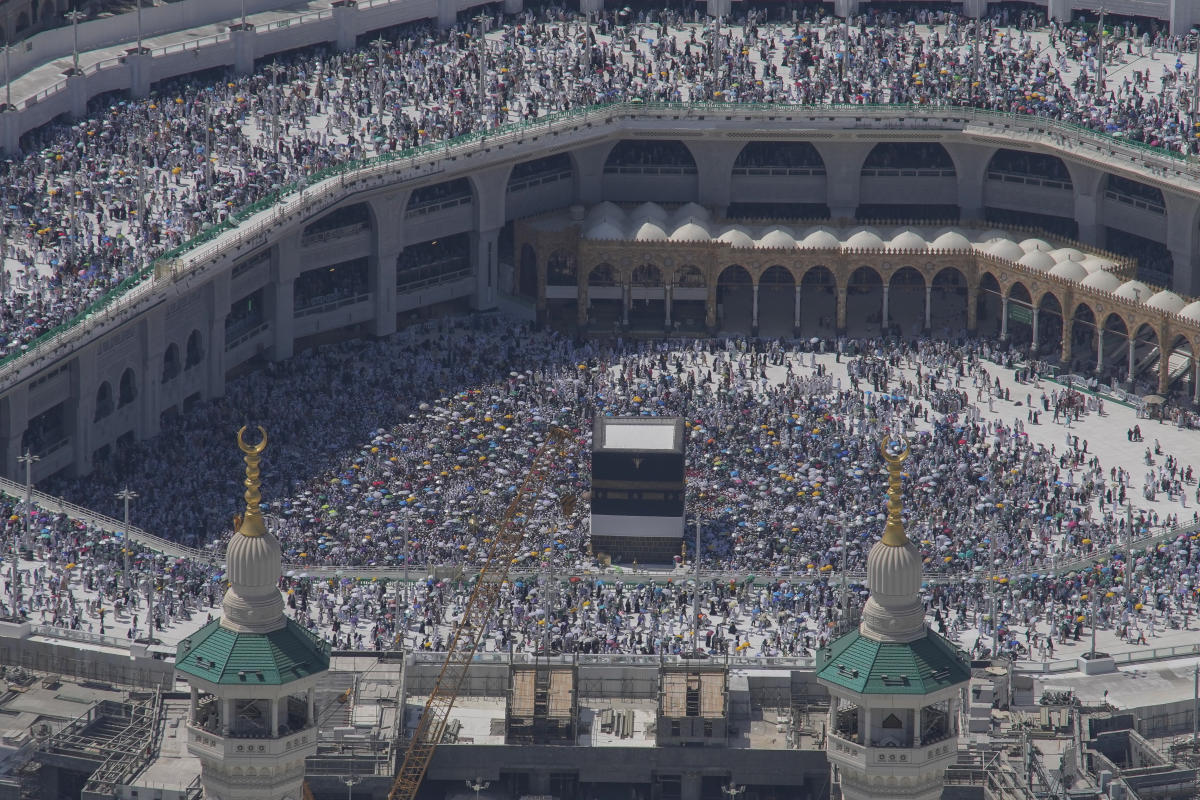Death toll during Hajj pilgrimage rises to 1,300 in scorching temperatures

CAIRO (AP) — More than 1,300 pilgrims have died in the scorching heat during this year’s hajj pilgrimage, Saudi Arabia’s health minister said Sunday.
In an interview with state television, Health Minister Fahd bin Abdurrahman Al-Jalajel said that 83 percent of the deaths were due to pilgrims without valid entry permits who had walked long distances in the scorching heat.
More than 660 people from Egypt were among the dead, two officials in Cairo said.
THIS IS A BREAKING NEWS. AP’s earlier story follows below.
CAIRO (AP) — More than 1,000 people have died during this year’s hajj pilgrimage in Saudi Arabia as worshippers faced extremely high temperatures at the desert kingdom’s Islamic holy sites, officials said Sunday.
More than half of the fatalities were Egyptians, two officials in Cairo said. Egypt revoked the licenses of 16 travel agencies that had allowed illegal pilgrims to enter Saudi Arabia, authorities said.
Saudi Arabia has not commented on the deaths during the pilgrimage, which every responsible Muslim must undertake once in their life.
The Egyptian government announced that 31 authorized pilgrims died of chronic diseases during this year’s hajj, but did not release an official count of the remaining pilgrims. Egypt sent more than 50,000 authorized pilgrims to Saudi Arabia this year, the government said.
However, a Cabinet official said at least 630 other Egyptians had died during the pilgrimage, most of them at the emergency complex in Mecca’s Al-Muaisem neighborhood. An Egyptian diplomat confirmed the figure and said most of the dead had been buried in Saudi Arabia.
The officials spoke on condition of anonymity because they were not authorized to brief journalists.
Saudi authorities cracked down on illegal pilgrims, deporting tens of thousands of people. But many, especially Egyptians, managed to reach the holy sites in and around Mecca, some on foot. Unlike authorized pilgrims, they had no hotels to escape the scorching heat.
In its statement, the government said the 16 travel agencies had failed to provide adequate services to pilgrims. They had illegally facilitated pilgrims’ travel to Saudi Arabia by using visas that did not allow their holders to travel to Mecca.
The government also announced that representatives of the companies had been handed over to the public prosecutor’s office for investigation.
According to the state-run Al-Ahram daily, some travel agencies and Hajj tour operators sold Saudi tourist visas to Egyptian Hajj participants, violating Saudi regulations that require exclusive visas for pilgrims. These agencies left pilgrims in Mecca and the holy sites in the dark in the scorching heat, the newspaper said.
Among the fatalities were 165 pilgrims from Indonesia, 98 from India and dozens more from Jordan, Tunisia, Morocco, Algeria and Malaysia, according to an Associated Press count. Two US pilgrims were also reported dead.
The AP could not independently confirm the cause of death, but some countries, such as Jordan and Tunisia, blamed the scorching heat. Saudi officials did not respond to questions seeking more information.
Associated Press journalists saw pilgrims fainting during the hajj, especially on the second and third days, due to the scorching heat. Some vomited and collapsed.
Deaths are not uncommon during the Hajj. At times, over two million people traveled to Saudi Arabia for a five-day pilgrimage. In the history of the pilgrimage, there have also been mass panics and epidemics.
However, this year’s balance was unusually high, suggesting exceptional circumstances.
In 2015, more than 2,400 pilgrims were killed in a stampede in Mina. According to an AP count, this was the worst incident to ever hit the pilgrimage site. Saudi Arabia has never released the exact number of victims of the stampede. A crane collapse at the Grand Mosque in Mecca earlier that year killed 111 people.
The second deadliest incident during the Hajj was a stampede in 1990 that left 1,426 people dead.
During this year’s hajj, daily maximum temperatures in Mecca and at holy sites in and around the city ranged between 46 and 49 degrees Celsius, according to the Saudi National Center for Meteorology. Some people fainted while attempting to perform the symbolic stoning of the devil.
Hajj, one of the five pillars of Islam, is one of the largest religious gatherings in the world. According to Saudi Hajj authorities, more than 1.83 million Muslims performed Hajj in 2024, including more than 1.6 million from 22 countries and around 222,000 Saudi citizens and residents.
Saudi Arabia has spent billions of dollars to control crowds and ensure the safety of participants in the annual five-day pilgrimage, but the sheer number of participants makes it difficult to ensure their safety.
Climate change could increase the risk even further. A 2019 study by experts at the Massachusetts Institute of Technology found that even if the world managed to mitigate the worst effects of climate change, the hajj from 2047 to 2052 and from 2079 to 2086 would take place in temperatures exceeding an “extreme danger threshold.”
Islam follows the lunar calendar, so Hajj occurs about 11 days earlier each year. Starting in 2029, Hajj will occur in April, and in subsequent years it will fall in winter when temperatures are milder.



